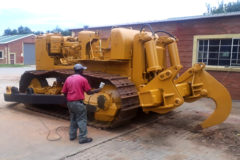The 1970s Chubb Pursuer crash tender
Posted by Chris Graham on 16th May 2021
Ron Henderson tells the story of the Chubb Pursuer crash tender; an airfield accident response vehicle that ended up on the road, instead.

The 1970s Chubb Pursuer: A Chubb publicity photograph showing the standard form of the Pursuer. This was part of an order for various fire items of fire equipment shipped out to Saudi Arabia which, at one time, depended heavily on British-made equipment.
In 1975, Chubb Fire Security Ltd, of Sunbury on Thames, Middlesex, introduced a high-performance airfield crash tender for rapid intervention purposes, with the notion of it being able to arrive at an incident ahead of the main fire-fighting force.
Called the Pursuer, the new 4×4 vehicle was based on a Reynolds Boughton Pegasus chassis, driven by a rear-mounted Chrysler H440 V8 petrol engine. This unit developed 225hp at 4,400rpm, and was capable of accelerating the vehicle from zero to 50mph in less than 20 seconds, then on to a top speed of 65mph. Optional was a Rolls-Royce B81 petrol engine producing 235hp. Transmission was through an Allison TC370, three-element torque converter, to a fully automatic MT640 four-speed gearbox.
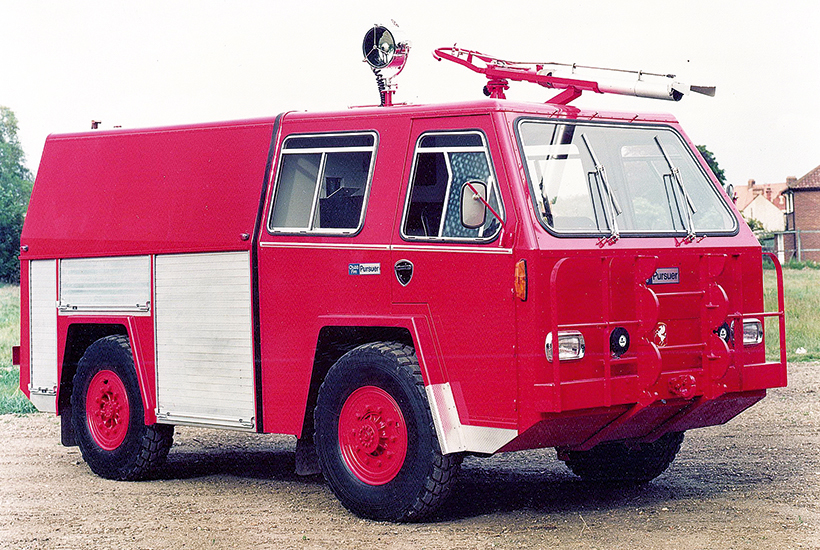
Another pre-delivery view of a Pursuer. This one features an intricate form of crash barrier featuring special feeders for drawing in and cutting wire fencing. This was a characteristic of those ordered and cancelled by the Australian Department of Air Transport.
Two basic versions were offered; one for airport use and the other for motorway fire-fighting patrol work. Carrying 300 gallons of water, 20 gallons of protein foam liquid and a Godiva 500/600-gallons-per-minute pump, up to 3,000 gallons of expanded foam could be dispensed from the manually-operated roof monitor, to a distance of 150ft, in 45 seconds.
It was professed by the manufacturer that the machine was, therefore, capable of dealing with most emergency situations single-handedly. For airport fire-fighting, a two-man crew was specified, with four-door cabs being available as an option for the motorway response vehicles.
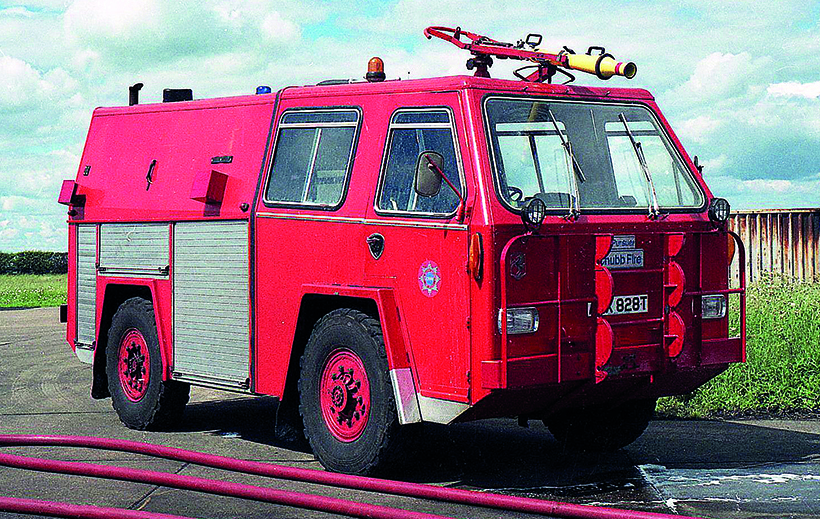
A rare, British Chubb Pursuer that was seldom seen by the general public. This one was acquired by the Civil Aviation Authority, purely as a training vehicle for use at Stansted and later, Teesside, airports. The sheep wire cutters on the front are indications of the cancelled Australian order. This machine still survives thanks to gaining further service at small airfields at Staverton and Welshpool.
Orders promptly ensued from the Australian Department of Air Transport Group for six units, while several others were exported to Oman and Saudi Arabia in the Middle East. However, the Australian order for Rolls-Royce-powered versions was later cancelled. In the United Kingdom, only two airfield versions were sold. Both were cancelled export orders, and one of was acquired by the Civil Aviation Authority and used solely as a training vehicle at the Civil Aviation’s fire-fighting training school at Stanstead, later Teesside Airport.
The other one was hidden away from public view in Scotland, at the Nuclear Power Development Establishment’s Dounreay plant. Subsequently, it became more accessible, but only just, when it was acquired by Highlands & Islands Airport Authority, and posted to Barra Airport in the Outer Hebrides.

The unique, West Sussex Chubb Pursuer rapid intervention tender, pictured at the 1975 Interfire exhibition at Olympia. This must be one of the most unusual fire engines ever to grace Britain’s roads.
United Kingdom sales for the futuristic vehicle were disappointing, but another version of rapid-intervention vehicle, specially designed for the British Airports Authority, was more successful. Costing £39,000 and named the ‘Spearhead’, its introduction was expected to shave up to one minute off the attendance times to incidents on the airport ground, where the regulations stipulated that the first fire engine should be at the scene of a fire anywhere within the airport perimeter in no more than three minutes.
Fire-fighting equipment included 2,000 gallons of pre-mixed Light Water, plus 50kg of a chemical extinguisher, for use on electrical or engine fires. Devoid of a roof monitor, the foam was discharged through hand-held hose lines and a hose reel, conveniently housed in a locker in the front panel of the cab, which necessitated the redesign of the front assembly.
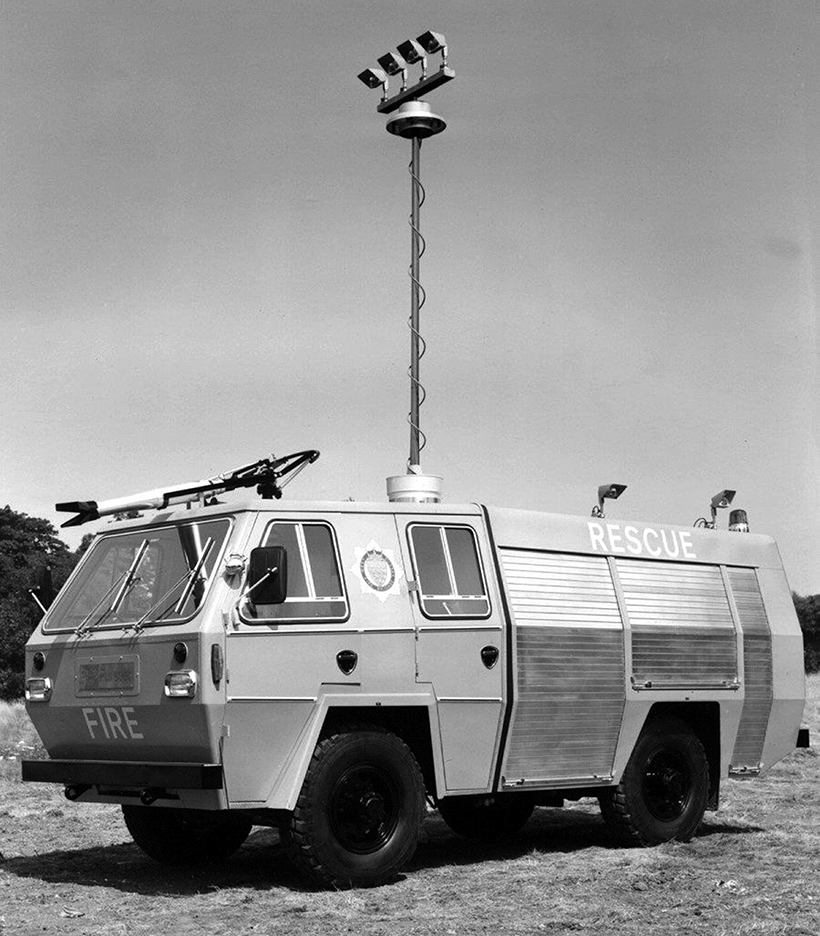
A publicity photograph of the West Sussex Pursuer, showing the extending Stem-Lite and side-mounted scene lights – important accessories when attending motorway incidents. This is another vehicle that survives today, having operated at Redhill, Halfpenny Green and Caernarfon airfields, following its disposal from West Sussex Fire Brigade in 1990.
A wide array of rescue gear was carried, including breathing apparatus, floodlights and hydraulic cutting tools. Fourteen examples were ordered by BAA, for service at the authority’s seven airports – Heathrow, Gatwick, Stansted, Prestwick, Edinburgh, Aberdeen and Glasgow. They were the only ones built and, apart from the one at Heathrow, would be little seen by the general public.
Heathrow was the exception, as the main airport fire station was situated outside of the airport, on the northern perimeter road and the appliances frequently travelled on the public roads while attending incidents, especially those of a domestic nature in the terminals and other outside premises.
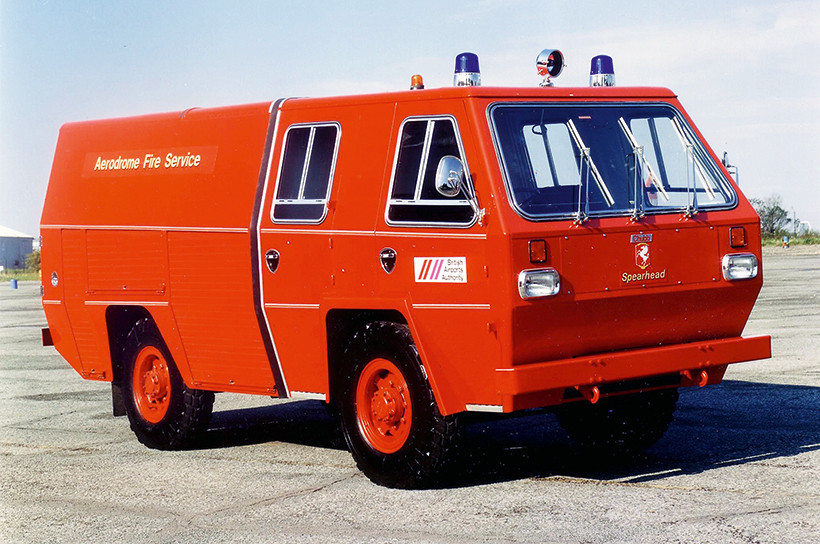
This one, with the ‘Spearhead’ name on the front, was the prototype for British Airports Authority, but bore little resemblance to the production models. It was later rebuilt to match the production models and, when surplus to requirements, saw further service at White Waltham Airfield.
When disposed of, some of them saw service at the smaller, private airfields, such as Biggin Hill and the West London Aero Services airfield at White Waltham, which operated the prototype. No less than seven of the 14 ended up at the aircraft museum at Duxford. Fortunately, a few of them have survived with private owners.
The best place to have seen a Pursuer fire engine was at Crawley, West Sussex. The West Sussex Fire Brigade purchased one in 1975, and was the only municipal fire service to take up the option of buying one for operation on the general road network in the county. Stationed at Crawley Fire Station, just outside Gatwick Airport, it was used for responding to road accidents.
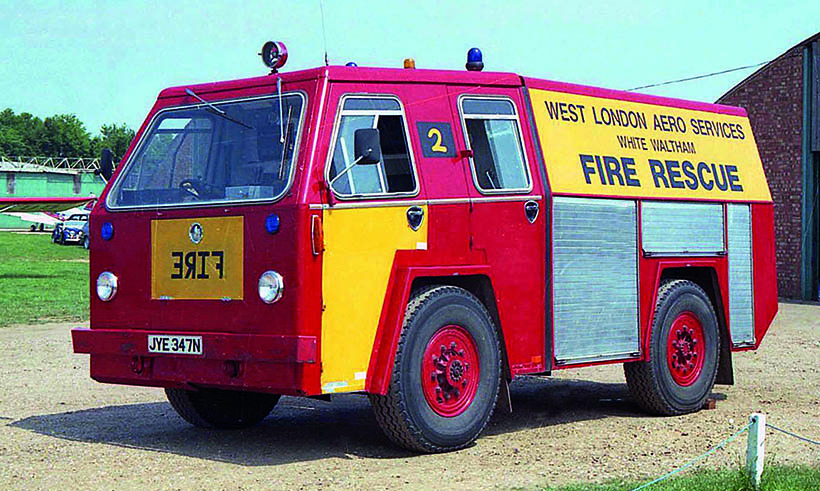
The prototype ‘Spearhead’ showing the adaptations that were required to the front assembly by British Airports Authority, to accommodate a hose reel situated in the drop-down yellow locker door at the front. There is no mistaking where this photograph was taken.
A mini version of Chubb’s massive 37-ton Pathfinder, this version had an overall weight of just seven tons and, unlike the standard airport versions, featured a four-door cab and roof-mounted telescopic lighting unit. This was a strange choice for a vehicle designed predominantly for careering around airfields. Sold in 1990, it saw further service with Bristow Helicopters Ltd, at Redhill and, from there, went to Halfpenny Green Airport, near Wolverhampton.
For a money-saving subscription to Vintage Roadscene magazine, simply click here




